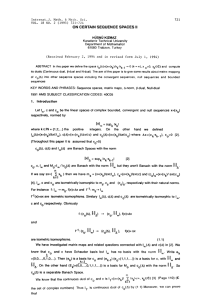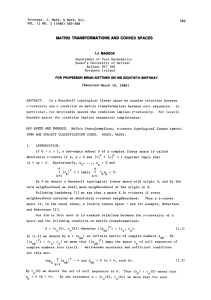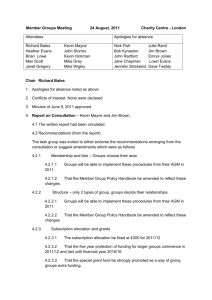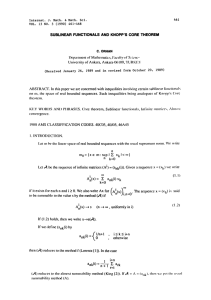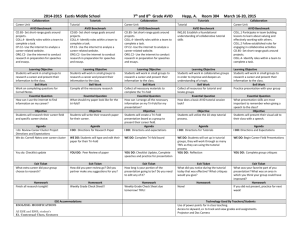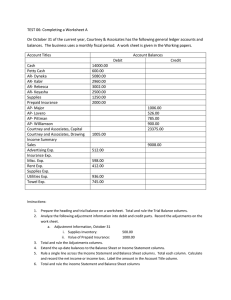k} CONVERGENCE INDEPENDENT AND
advertisement
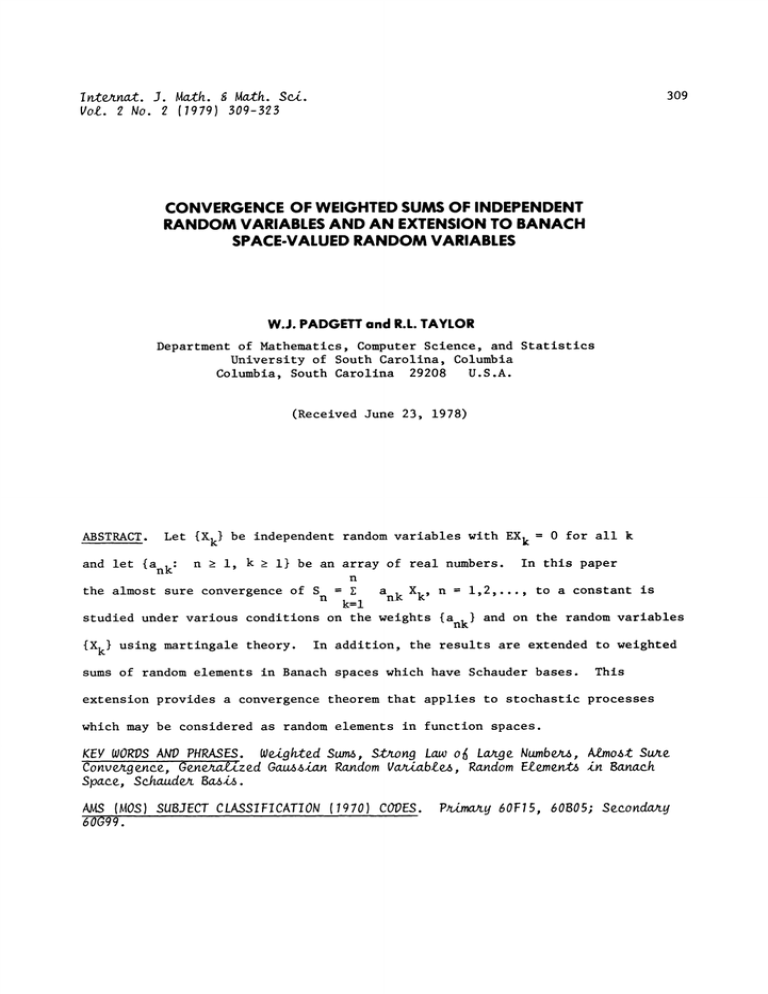
I ntrnat. J. Math. & Math. Sci.
Vol. 2 No. 2 (1979) 309-323
309
CONVERGENCE OF WEIGHTED SUMS OF INDEPENDENT
RANDOM VARIABLES AND AN EXTENSION TO BANACH
SPACE-VALUED RANDOM VARIABLES
W.J. PADGETT and R.L. TAYLOR
Department of Mathematics, Computer Science, and Statistics
University of South Carolina, Columbia
U.S.A.
Columbia, South Carolina 29208
(Received June 23, 1978)
ABSTRACT.
Let {X k} be independent random variables with EX k
n > i, k > i} be an array of real numbers.
n
a
n
the almost sure convergence of S
1,2,
E
n
nk Xk,
and let
{ank:
k=l
studied under various conditions on the weights
{Xk} using martingale theory.
{ank}
0 for all k
In this paper
to a constant is
and on the random variables
In addition, the results are extended to weighted
sums of random elements in Banach spaces which have Schauder bases.
This
extension provides a convergence theorem that applies to stochastic processes
which may be considered as random elements in function spaces.
KEY WORDS AND PHRASES. Weighted Sums, Strong Law of Large Numbers, Almost Se
Convergence, Generzed Gaussian Random Variables, Random Elements in Banach
Space, Schauder Basis.
AMS (MOS) SUBJECT CLASSIFICATION (1970) CODES.
60G99.
Primary 60F15, 60B05; Secondary
W. J. PADGETT AND R. L. TAYLOR
310
INTRODUCTION.
i.
Let (,
F, P)
denote a probability space and let
}
be a sequence of
E
1,2,
Let
independent random variables with
{ank
n
0 for all k
n e i, k e i} be an array of real numbers and define S
Z
n
a
k=l
nk
1,2,
’
Several results have been obtained in recent years concerning the almost
sure convergence of the sequence {S } under various conditions on the weights
n
{ank}
and boundedness conditions on the random variables
{}
or on their
For example, Chow (1966) and Stout (1968) required conditions on
2 <
a
such as (i) E
K nY for some constants K and y or
nk
2
%
<
Z ank
(ii) A
for all n and l exp(--) <
for all % > 0, and
n
moments.
{ank}
k--i
n--i
n
either a uniform bound on certain moments of the random variables
condition that for all k,
real numbers t.
E[exp(t)]
(a2 = 2 /2)
< exp
Stout’s (1968) results concerned
{}
or the
for some a > 0 and all
the complete convergence of
{Sn} in the sense of Hsu and Robbins (1947) which implies almost sure convergence.
{Sn }
Also, Rohatgi (1971) considered the almost sure convergence of
there exists a random variable X such that
and all k, where X has a finite (I
that
Z
{} in the sense that
e[lla] e[IXla] for all a
to zero by requiring the uniform dominance of
+ I/a)th
absolute moment and
> 0
> 0 is such
0 (n-a). (It was also assumed that lim
0 for all k and
maXlank
n-o ank
k
Chow and Lai (1973) have studied
lank C for all n.) More recently,
i
k=l
the almost sure converzence of
{n-
S } (some i
2) for independent and
identically distributed random variables with finite th absolute moments and
with somewhat weaker conditions on the array
{ank}
than those in Stout (1968).
Lai (1974) has indicated the importance of weighted sums in control charts.
CONVERGENCE OF RANDOM VARIABLES
311
Chow (1966) defined a random variable X to be generalized Gaussian if
there exists a number
> 0
(referred to here as the parameter) such that for
2
every real number t, E[exp(t X)] < exp(
t2/2).
Special cases of generalized
Gaussian random variables are normal with zero means or bounded, symmetric
random variables.
In Section 2 of this paper the definition of a totally .$eneralized
Gaussian random variable is given.
Then the almost sure convergence of {S }
n
for independent (but not necessarily identically distributed) random variables
which are totally generalized Gaussian is obtained using martingale theory
with very general conditions on the sequence of weights
{ank}.
The
relaxation of the restrictions on the weights which is achieved in these re-
sults is
summarized and discussed in Section 3.
in Section 4 the
Also
results for random variables are extended to sequences of independent random
elements in separable Banach spaces.
This extension will provide a convergence
theory for weighted sums of stochastic processes which
mav be considered as
random elements in function spaces, such as the Wiener process on a closed
interval [0, T] for some T > 0 [see Billingsley (1968)].
2.
WEIGHTED SUMS OF RANDOM VARIABLES.
Let
{ank:
n > i, k > i} be a double sequence of real numbers satisfying
the following conditions:
(i)
ank
> 0 for all k and n,
(2)
2
Y.
ank
k=l
3
2
E
k=n+l
(4) lira
n
E ank for all n;
k=n
_< F for all n and some positive constant r;
1,2,...,n-i and
for k
ank
an_l, k > ank
E an-l,k >
k=n
anl"
/
0 as n
/
0 for all k.
; and
W. J. PADGETT AND R. L. TAYLOR
312
A sequence
{ank}
satisfying Conditions (1)-(4) will be called a Type (P)
sequence.
Conditions (1)-(4) will be considered in detail in Section 3, and sev-
eral examples of sequences which are of Type (P) will be given there.
Those
examples will contrast previous results with the results which are given in
this section and will show that the weights can be very different from the
traditional weights
n
ank
-I
if k
i,..., n.
However, in Section 3, the
traditional weighting is shown to be a special case of a Type (P) sequence
by letting
-3/4 if k
k
ank
DEFINITION i.
EX exists.
X+
X
l,et
+
n
i,
X be a random variable such that its expected value
Let I be the indicator random variable for the event A, and let
A
I[X
> 0]
and
X-
-X
generalized Gaussian if
< 2 1/2 and
X-
EX-
I[X<0].
+
X +- EX
Then X will be said to be totally
is generalized Gaussian with parameter
is generalized Gaussian with parameter
< 2 1/2
We now prove the following theorem.
-
THEOREM i.
each k and let
Let
{ank}
{}
be independent random variables with
be a Type (P) sequence.
E
If for each k,
0 for
is totally
generalized Gaussian, then there exists a constant y such that as n-o
n
$
7
y almost surely.
n
k=l ank
PROOF.
Then
,
For each k, let X and
k
k
1,2
be defined as in Definition i.
Also, define
F+n
{X
X+}
n
to be
sigma-field generated by
n
ank and
n
n
k=l
1,2,
for n
E ank
S
n
kffil
are independent random variables, and by hypothesis we may
Now,
X1,...
{}
obtain for every k
_<
exp (t
2
+
tEXt)
(2.1)
CONVERGENCE OF RANDOM VARIABLES
for all real numbers t.
.
Define
313
n
n
n
{ank}
2 by Condition (I) on
Then for n
ank
k=n+l
g
akk
k=l
),
1,2,
n
and inequality (2.1) we obtain
n
n
n-I
exp
ank
k=n+l
k=l
n-i
F+
2
k=l
]
k=n+l
n
x
=p(-
I
n-I
n
k=l
k=l
k+l
n-i
(
+
ank
i
2
ank)P(a
k=n+l
2
nn
v+
+ ann
E)
n
xexp (-
I a)
k=l
n-i
=p(
ank
k=l
K+
2
ank
k
n-i
akk
k=l
g
n-I
n-i
k
Y-I
{Y}
(-
2
k=l
Hence,
n-i
p
k-
i
a.s.
is a pertinEale th respect to
{}.
For each n
E[exp(S+
EIY+n
n
[
kffil
n
[H
k=l
k=l
)]]p
E[P(ank
kffin+l
+
P(ank + ank E.)]
2
2
exp
k=l
_<
n
v+
ank-k=l akk E.)]
2
+
exp (r)<
ank)
[[ (ank
k=l
k=n+l
)
i
2
p(
n
p
E
ank-
ank-
a) E+]
n
a)
W. J. PADGETT AND R. L. TAYLOR
314
by inequality (2.1) and Conditions (i) (that
and (2) on the
{ank}.
Thus
EIY+I
sup
n
<
an_l,k> ank
1,2,
for k
n-i
o, and by the martingale convergence
theorem [Tucker (1967)], there is a random variable Z
y+n/Z I
I such that
a.s.
By Condition (3) of a Type (P) sequence, there exists a random variable Z
such that S
variable Z
+
n
n- Ek=l
akk
/Z
a.s.
I
S-n ik=in
such that
2
E
$/
E. Hence, Sn
n
+
(Sn Y’k=l akk m)
E
S
n
(S n
akk E/Z 2
n
n
akk m)/
Y’k=l
Next, EXk
a.s.
Z
Z
I
Z
2
By Condition (4) of Type (P) sequence, for each j
a.s. as n-o.
+ annXn
+ an,k_l
n
Sn (anlXl +
Therefore,
I
Similarly, there exists a random
-i
0 implies that
a.s.
1,2,...
anj Xj 0
+
+
(ank
Z a.s. implies that for every k,
a X / Z a s
Thus,
j--k n j
Z is measurable with respect to the tail sigma-field of
and there exists
/
{}
I, Tucker (1967, p. 75).
a constantysuch that P[Z --y]
a.s.
Therefore, S n /y
III
If, in addition to the Conditions (1)-(4), the sequence
n
2
Y.
the condition that
0 as
ank
k=l
{ank}
satisfies
n-o, then the following theorem may be ob-
tained.
{}
Let
THEOREM 2.
be a sequence of independent random variables with
{ank}
be a Type (P) sequence.
n
2 /
0 as n
generalized Gaussian for each k, and if
n
k=l
0 almost surely as n /
EXk
0 for all k, and let
ank
Sn
PROOF.
surely.
ank
+
/
.
,
is totally
then
By Theorem i, there exists a constant y such that S n * y almost
Hence, S
/
n
proof of Theorem i.
for 4>0
k=F’l
If
’
in probability.
Define
n+
E$
Let S
+
n
n
k=l
r.
+
n
and
ank
S-n
EXI
be defined as in the
By Chebyshev’s inequality
315
CONVERGENCE OF RANDOM VARIABLES
n- n
var
E
0
Since
() E(0 )2
var(S
> ] -<
ank vat(
k--i
).
< 2 and mean zero,
is generallzed Gausslan with
is uniformly bounded for all k by a positive constant B.
Thus,
n+ I> ]--2Bk=l ank2 0 as n
+
That is, S
n
n+ 0 probability as n
The same argument gives S
n
n 0
results yields Sn--(S+
bining the
-n n+)
p[
IS+n
/
/
in
/
.
two
This implies that
That is
S
/
n
y
/
.
in probability as n
/
n
by hypothesis.
/
(Sn-
n
/
/
.
Hence, com-
0 in-probability as
0 since the limit in probability is unique.
0 a.s. ///
To obtain convergence of weighted sums of random variables which are not
identically distributed, dominance of the random variable by an integrable
random variable or in some other sense is not an unusual condition {see Chow
(1966), Stout (1968), or Rohatgi (1971)).
trictlon.
However, it is a troublesome res-
The strength provided by the results of this section is in the
relaxation of conditions on the weights
{ank}.
An examination of the weights
which are of Type (P) is provided in the next section.
3.
CONDITIONS ON THE WEIGHTS.
In this section the conditions on the weights will be examined.
In par-
ticular, the Type (P) sequences will be shown to be different from the weights
used in previous results.
A strong law of large numbers can be obtained from
n
these results, but the sequence {
7.
k=l
ank:
n >_ I} need not be bounded in gen-
eral.
The first example will consist of weights
{ank}
which satisfy Conditions
316
W. J. PADGETT AND R. L. TAYLOR
n
2 /
Y.
0 as n / but which do not satisfy the conditions of
ank
k=l
Theorem 4 of Stout (1968) or Theorem I of Chow (1966). Define
(1)-(4) and
i
Then (I)
where >0.
k-(l+)
[Zn(n+l)] 2
ank
1 2
k,n
(4) hold and for all n
n
2
Y.
[#.n(n+l) ]
k=l
ank
-I Zn
k=l
k
X
-< [Zn(n+l)]
X
n=l
k2+2:
X n+l
k=l
ank Zn (n+l)
> 0.
Thus,
=,
i
i
7.
X
k=l
0 as n
i
Za (n+l) X
k__Ei k2+2e
exp(-X/A_),,
/
’2’2:
/
k
k=l
However, An
i
2+2(
where
exp[-Zn(n+l)]
X
n=l
which does not satisfy the hypothesis of
Stout’s (1968) Theorem
n=l
4 or Chow’s (1966) Theorem i.
For the next example, define
-I
n
if k
1,2,..., n
k-3/4"
if k
n+l, n+2,
ank
This sequence satisfies Conditions
(1)-(4), and hence a strong law of large
However, since the second
numbers is available from the results of Section 2.
moments of the random variables in Theorem 2 can be uniformly bounded,
Kolmogorov’s criterion is easily satisfied for the weights
and convergence of S
n
follows immediately.
n
{ I
k=l
For example, define
-I i-< k<
n,
n
Thus, these results are most use-
ful when considering nonuniform weighting where
unbounded.
ank
ank
n> i} may be
317
CONVERGENCE OF RANDOM VARIABLES
n
7.
ank
J
j=n+l
3/2
0
if k
1,2,...,n
if k
n+l
if k > n+l.
This sequence is also of Type (P).
Conditions (i) and (2) imply that
Z
a,.,. < F.
k--i
Thus, Kronecker type arguments would suffice for weights
{ank}
where the de-
crease down the diagonal of the summability matrix offsets the possible
decrease along the rows, for example, if
a
n,k+l
akk
>
However
ank ak+l,k+l"
letting
n-1/2 /n(k+7)
if k-- i,..., n-i
-i
n
ank
Z
if k=n
j-2)1/2
if k
n+l
J--n+l
if k > n+l
0
defines weights which are of Type (P) but which have the property that for
each k there exists an n such that
an,k+l akk < ank ak+l,
-k
if k
-i
if k=n
n
n
Moreover,
k+l"
j-2)1/2
if k
l,...,n-I
n+l
j=n+l
if k> n+l
0
defines extremely nonuniform weights which are of Type (P) but such that for
every n >2,
an,k+I akk < ank ak+l,k+I
for each k
i,..., n-2.
W. J. PADGETT AND R. L. TAYLOR
318
An exhaustive discussion of the weights which are of Type (P) will not
be presented, but it is important to note that this more general condition
on the weights is balanced by the assumption of total generalized Gaussian
nonidentically distributed random variables.
4.
EXTENSION TO RANDOM ELEMENTS IN A BANACH SPACE.
In this section an extension of Theorem 2 for random elements in a
Banach space will be obtained.
The study of random elements in abstract
spaces was inspired by the consideration of stochastic processes as random
elements in appropriate spaces of functions [see, for example Mann (1951) and
Billingsley (1968)], and various properties of random variables have been
extended to random elements.
In particular, laws of large numbers for random
elements in abstract spaces have been studied extensively [see Padgett and
Taylor (1973), for example, and Alf (1975a) for a more recent result].
Also,
Alf (1975b) has extended the results of Jamison, Orey, and Pruitt (1965) to
weighted sums of random elements in a Banach space.
Let X denote a (real) separable
(, F, P) be a probability space.
Bam_h
space with norm
II
II,
and let
A random element V in X is a measurable
function (with respect to the smallest sigma-field generated by the open subsets of
X) from
into
X.
The random elements {V } in
tically distributed if their induced probabilities on
X are said
X are
to be iden-
the same.
Further, {Vn } are said to be independent if for every finite collection
{BI,
B
k}
of Borel subsets of
P[VI
B I,
X
...,
k
VkBk]
i=l
P[ViBi].
An expected value for a random element V in X will be defined by the Pettis
integral.
That is, V has expected value
EVX
if f(EV)
Elf(V)] for every
CONVERGENCE OF RANDOM VARIABLES
continuous linear functional f on
319
X.
A Schauder basis for a Banach space X is a sequence {b i}
for each
xeX
x
Y.
lira
n-o i=l
there exists a unique sequence of scalars {t
t
b
i
i}
c
X such that
satisfying
A sequence of linear operators {U } can be defined on X
n
i.
by
n
Un(X)
for
xe
i(x)
where f
X,
a Banach space
on
X.
(x)
l
i=l
fi(x)bi,
n-- 1,2,
the coordinate functionals are continuous linear functionals
Further, a sequence of linear operators
x
Un(X),
xX,
II
< m
+
i for all n,
may be defined on X by
It is well-known that for a Banach
1,2,
n
{}
space there exists a basis constant m. > 0 such that
hence
For
t. is the ith coordinate functional for the basis.
Marti
IUnl l<m for all n,
and
(1969) and Wilansky (1964).
Theorem 3 extends Theorem 2 to Banach spaces which have Schauder bases.
A definition is needed first.
DEFINITION 2.
Let V be a random element in a Banach space X which has
a Schauder basis with coordinate functionals
{f.}.
Then V is coordinatewise
totally generalized Gaussian if f i(V) is a totally generalized Gaussian ran-
1,2,
dom variable for each i
THEOREM 3.
Let
X
be a Banach space with a Schauder basis {b
{Vk} be independent random elements
in
X such that EV k
0.
Let
i} and let
{ank} be
1,2,..., Vk is a coordinatewise totally generalized Gaussian random element (with respect to the basis
a Type (P) sequence.
{bi})
Suppose that for each k
that for sufficiently large positive integers p the random variables
{llQp(Vk) II-gllqp(Vk)ll}k=l
are generalized Gaussian wlth parameters
and that as p-o there exist constants
Cp, Cp/
0, such that
k<21/2,
W. J. PADGETT AND R. L. TAYLOR
320
n
sup Z k=,
Is=ll
2
nkEIIQp(Vk) ll -<C. fk=. an"-*n/’
II kl ank Vkll/ 0 almost surely.
PROOF.
For each n and p, write
n
S
:hnn/
n
n
I
k=l
n
7,
V
ank
k--i
Z
k--1
k
+
Up(Vk)
ank
(4.1)
ank Qp(Vk)
Let p be a fixed positive integer and consider
n
p
lUp (k=Zl
n
ank Vk) ll II i=
_<
p
Z
1
f
(fi }
lfil
Z
k=l
ank fi (Vk) l"
are the coordinate functionals for the basis.
0, i-- i,..., p, for each i-- 1,2,..., P’
Ibi
I,
(4.2)
Now since
(fi(Vk)}mkll
fi(Evk)
E[fi(Vk)
of independent random variables with
l"
n
i=l
where
i(kZl= ank Vk)bi
is a sequence
0 for all k.
Thus,
is totally generalized Gaussian for each k and i=
by Theorem 2, since f
n
+ 0 almost surely as n /
for each i. Thus,
1,2,..., p, Z
ank
kl
0 such that
from (4.2) for each p there exists an event
with
i(Vk)
fi (Vk)
m
P
> 0 there is an integer N
implies that for
n
Iup(kZ__l
ank Vk())
n
Now, consider
lQp(
.
k=IZ
<
ank Vk) II"
Thus,
E
Iqp(Vk)
so that for n>N
Qp
{Qp(Vk) }k= I
is a
is a continuous linear
independent random
Thus, by Theorem 2, since
is (totally) generalized Gaussian for each k
large p), as n
I
(4.3)
{(llQp(Vk) ll-EIIQp(Vk)ll)}k-i are
variables with zero means for each p.
I
For each p,
sequence of independent random elements since
operator
P(p)
P
(and sufficiently
/
n
l
k=l
ank[l IQp(Vk)
EIIQp(Vk)
I]
/
0
(4.4)
CONVERGENCE OF RANDOM VARIABLES
321
almost surely.
Now,
n
lQp(kE=l
n
7.
II k=l
ank Vk) ll
n
<
l
k=l
+
Y.
k=l
ank Qp
ank[IIQp(Vk) II
E
lIQp
n
But, by hypothesis sup Z n
(fixed)
n
Z
k=l
where
ank
EIIQp(Vk) II.
ank Ell Qp (Vk) II<Cp"
k=l
n
there exists an integer N
Po’
(4.5)
Also
an_k El IQpo(Vk) <
P() 0, there exlsts an
"
2
For > 0 and a large
such that for n N
2,
for sufficiently large
integer N
3
such that n N
that
Y.
k=l
ank[l IQp(Vk())
E
IQp(Vk)
I]
<
f
P
for p
Pl’
[[Sn()[] < []Up(kE__l
and for n _> max
ank
Vk())[l
+
0
{N1, N2, N3},
[[QP(k=ZI
3
-.
Therefore, from (4.i), (4.3), (4.5) and (4.6) for
g0--pl
Pl
ank
u
>
Po
and
I
aO
implies from (4.4)
,
(4.6)
where
Vk())[[ < "
III
Theorem 3 gives convergence results for random elements which need not
be identically distributed and which do not have restrictive moment conditions
(see the results of Padgett and Taylor (1976), for example).
ditlons on the weights
{ank}
Also, the con-
are very general as indicated in Section 3.
Moreover, the uniform dominance in probability of Rohatgl (1971) and Padgett
and Taylor (1974) is eliminated by the modified generalized Gausslan type of
condition.
Finally, if
X
n
R with the usual norm, then Theorem 3 gives a
convergence theorem for n-dimenslonal random vectors, and since f
l(x)
0
322
W. J. PADGETT AND R. L. TAYLOR
n, Qp(X)
for 1>n, xCR
0 for p>n, and only Inequality (4.3) is needed.
These results may be applied to stochastic processes.
For example,
Theorem 3 may be applied to sequences of separable Wiener processes on [0,i]
(or [0,T]) since such processes may be considered as random elements in the
Banach space C[0,1] [Billlngsley (1968)] which has a Schauder basis.
REFERENCES
Rates of convergence for the laws of large numbers for
independent Banach-valued random variables, J. Multivariate Anal.
5 (1975a) 322-329.
i.
Alf, Carol.
2.
Alf, Carol. Convergence of weighted sums of independent Banach-valued
random variables (abstract), I. M. S. Bulletin 4 (1975b) 139.
3.
Billingsley, P.
1968.
4.
Chow, Y. S. Some convergence theorems for independent random variables,
Ann. Math. Statist. 37 (1966) 1482-1493.
5.
Chow, Y. S. and Lai, T. L. Limiting behavior of weighted sums of independent random variables, Ann. Prob. i (1973) 810-824.
6.
Hsu, P. L. and Robbins, H. Complete convergence and the law of large
numbers, Proc. Nat. Acad. Sci. U. S. A. 33 (1947) 25-31.
7.
Jamison, B., Orey, S. and Pruitt, W. Convergence of weighted averages
of independent random variables, Z. Wahr. Verw. Gebiete 4 (1965) 4044.
8.
La, T. L. Control charts based on weighted sums, Ann. Statist. 2 (1974)
134.
9.
Mann, H. B.
Convergence of Probability Measures, Wiley, New York,
On the realization of stochastic processes by probability
distributions in function spaces, Sankhya ii (1951) 3-8,
i0.
Martl, J. T. Introduction o the Theory of Bases, Springer-Verlag,
New York, 1969.
ii.
Padgett, W. J. and Taylor, R. L. Laws of Large Numbers for Normed Linear
Spaces and Certain Frchet Spaces, Lecture Notes in Mathematics, Vol.
360, Springer-Verlag, Berlin-Heidelberg-New York, 1973.
CONVERGENCE OF RANDOM VARIABLES
12.
Padgett, W. J. and Taylor, R. L. Convergence of weighted sums of random
elements in Banach spaces and Frchet spaces, Bull. Inst. Math.,
Academia Sinica 2 (1974) 389-400.
13.
Padgett, W. J. and Taylor, R.
sums of random elements in
Spaces, Oberwolfach, 1975,
Vol. 526, Springer-Verlag,
14.
Rohatgi, V. K. Convergence of weighted sums of independent random
variables, Proc. Cambridge Philos. Soc. 69 (1971) 305-307.
15.
Stout, William F. Some results on the complete and almost sure convergence of linear combinations of independent random variables and
martingale differences, Ann. Math. Statist. 39 (1968) 1549-1562.
16.
Tucker, H. G. A Graduate Course in Probability, Academic Press,
New York, 1967.
17.
Wilansky, A.
L. Almost sure convergence of weighted
Banach spaces, Probability in Banach
A. Beck, Ed. Lecture Notes in Mathematics,
Berlin, 187-202, 1976.
Functional Analy.si.s, Blaisdell, New York, 1964.
323
